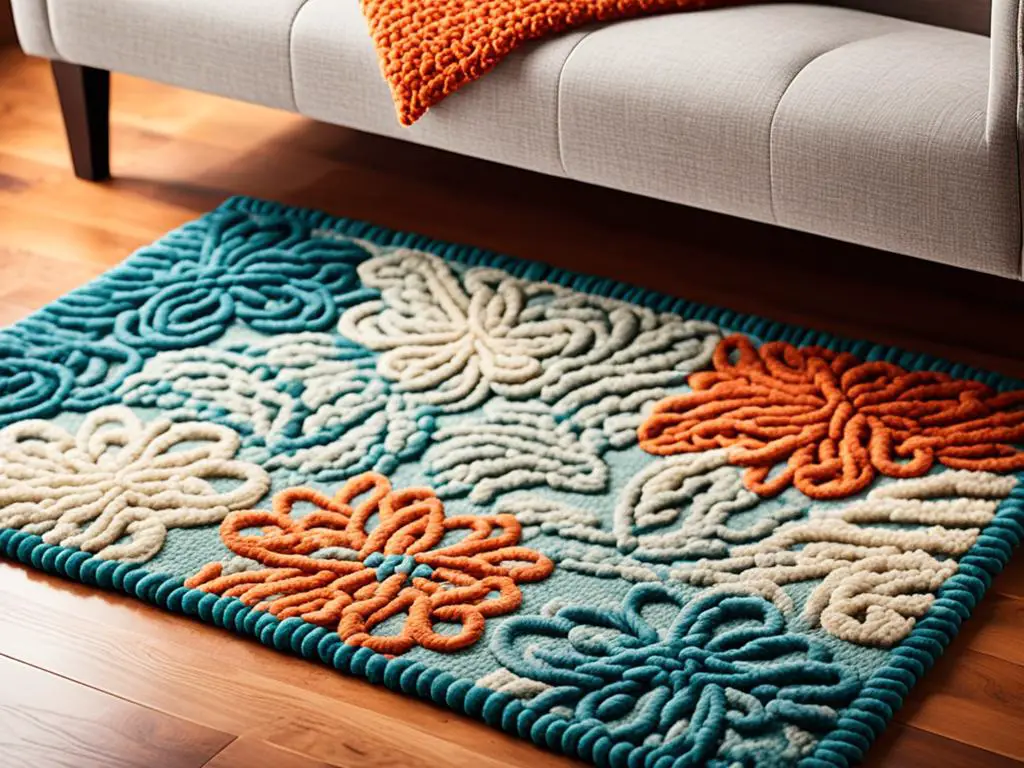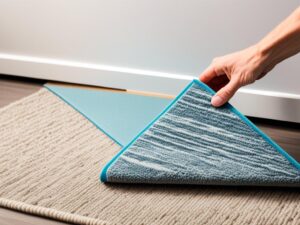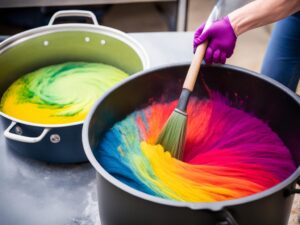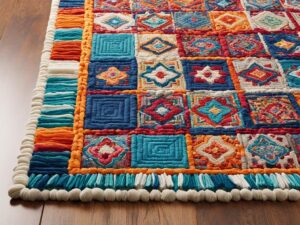A hooked rug is a unique and timeless form of textile art that adds warmth and beauty to any space. But what exactly is a hooked rug? Let’s dive into the definition and explore the fascinating world of this craft.
At its core, a hooked rug is a type of rug made by pulling lengths of cloth, typically wool, through a closely woven fabric, such as burlap. The process entails using a crochet-type hook mounted in a handle to pull loops of yarn or fabric through the backing material. The result is a rug with a textured surface created by the loops.
The materials used in hooked rugs vary, but wool strips ranging in width from 3/32 to 10/32 of an inch are commonly employed. These strips can be cut with precision using a mechanical cloth slitter or hand-cut for a more rustic look. Rug hooking allows for a wide range of designs, from elaborate patterns featuring flowers and animals to simple geometric shapes.
Rug hooking has a rich history in North America, dating back at least 200 years. It originated as a popular craft, particularly in New England and the Canadian Maritimes, among the economically disadvantaged. Hooked rugs were often made from scrap materials and fabric remnants, transforming discarded materials into works of art.
Key Takeaways:
- A hooked rug is a type of rug made by pulling loops of cloth through a woven fabric using a crochet-type hook.
- Wool strips are frequently used to create these rugs, with a variety of designs ranging from intricate patterns to simple shapes.
- The art of rug hooking has a long history in North America, beginning as a craft of the poor and evolving into a respected fine art form.
- Hooked rugs offer a versatile and beautiful option for home decor, adding texture and visual interest to any space.
- Exploring the world of hooked rugs allows for artistic expression and the opportunity to appreciate the craftsmanship of others.
Rug Hooking Techniques and Patterns
Rug hooking is a versatile craft that encompasses a variety of techniques and patterns. Whether you’re a beginner or an experienced rug hooker, there are endless possibilities to explore. From precision cutting to hand-tearing, each technique adds its own unique touch to your hooked rug. Let’s take a closer look at the different techniques and patterns used in the art of rug hooking.
Techniques
In rug hooking, the choice of technique can greatly impact the final outcome of your rug. Some crafters prefer using a mechanical cloth slitter to cut their fabric into precise strips, ensuring consistent width and length. This technique allows for fine detailing and intricate designs.
On the other hand, for those seeking a more primitive and rustic look, hand-cutting or tearing the strips provides a distinct charm. The irregular edges add character to the rug and create a textured appearance.
No matter which technique you choose, the process of rug hooking remains the same. Using a hook resembling a crochet hook, you pull loops of yarn or fabric through a backing material, such as burlap or linen. This repetitive motion gives rise to the unique texture and design of a hooked rug.
Patterns
Patterns play a crucial role in rug hooking, serving as the blueprint for your design. While some rug hookers enjoy creating their own patterns, others prefer using commercially-produced designs. These designs come in a wide range of complexity, from elaborate floral arrangements and lifelike animal portraits to simple and geometric shapes.
The choice of pattern depends on personal preference and the desired aesthetic. Some individuals enjoy the challenge of intricate designs, while others find solace in the simplicity of geometrics. Regardless of the pattern chosen, rug hooking allows for artistic expression and the creation of unique, one-of-a-kind pieces.
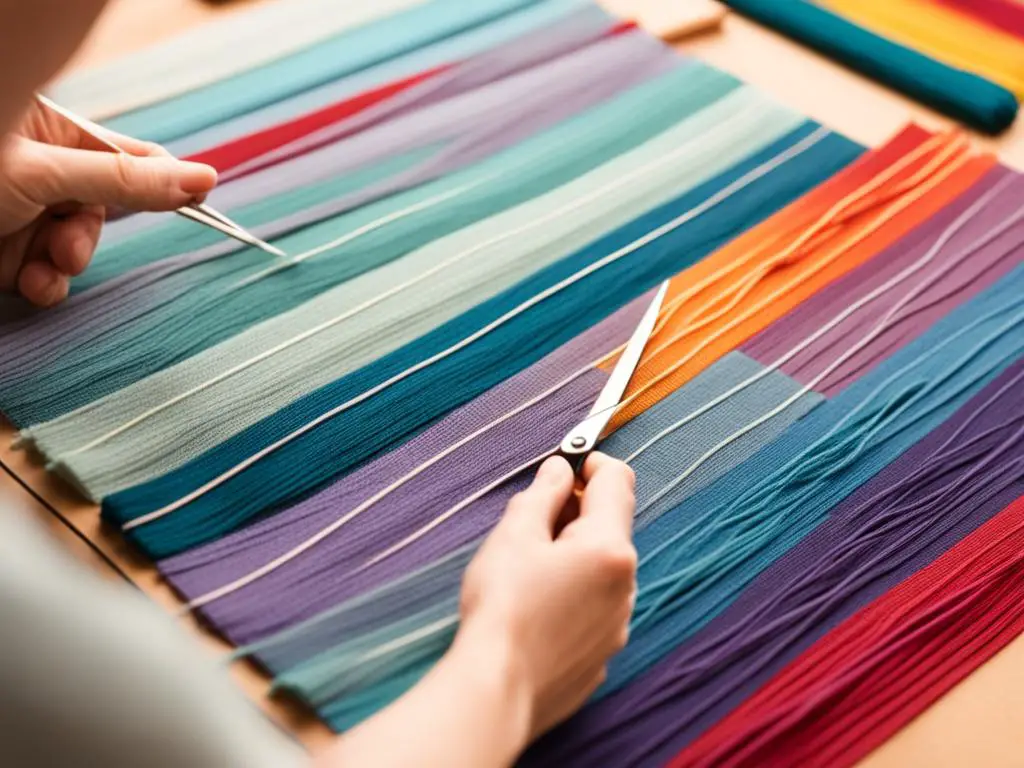
The History of Rug Hooking
The origins of rug hooking can be traced back to England in the early 19th century. During this time, floor mats made of thrums, which were pieces of yarn, were created. It is believed that the technique of hooking woolen loops through a base fabric may have been used by the Vikings and then brought to Scotland.
Rug hooking gained popularity in North America, particularly in New England and the Canadian Maritimes, where it evolved as a craft of the poor. In these regions, hooked rugs were made from scrap materials and fabric scraps, showcasing the creativity and resourcefulness of their makers.
Over time, rug hooking has transformed from a simple craft into a fine art form. Today, hooked rugs are not only appreciated for their beauty but also recognized as valuable pieces of cultural heritage. They have gained respect worldwide for their intricate designs, skilled craftsmanship, and historical significance.
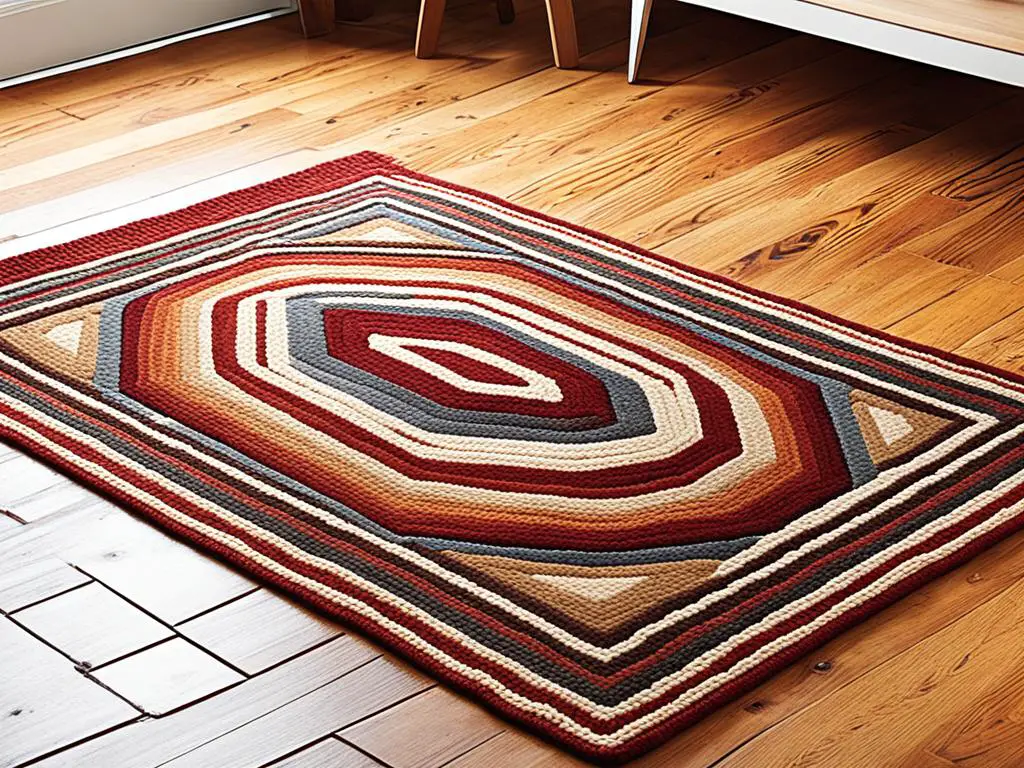
Influence of Traditional Hooked Rugs
Traditional hooked rugs continue to inspire modern rug hooking enthusiasts. The intricate patterns, vibrant colors, and rich textures of traditional rugs serve as a foundation for new artistic creations. Rug hookers often draw inspiration from historical designs and adapt them to create unique pieces that blend tradition with contemporary aesthetics.
“Traditional hooked rugs are a testament to human creativity and the ability to turn humble materials into beautiful works of art. They tell stories of the past, preserving cultural heritage and connecting generations.”
The Significance of Rug Hooking
Through the history of rug hooking, we can appreciate the resilience, resourcefulness, and artistic expression of the people who created these rugs. Rug hooking not only provided warmth and comfort but also served as a means of preserving memories and showcasing personal creativity. Today, it stands as a testament to human ingenuity and the enduring appeal of handmade crafts.
The Growth of Rug Hooking Communities
The popularity of rug hooking has led to the formation of vibrant communities of enthusiasts, artists, and collectors. These communities provide a platform for sharing knowledge, showcasing artwork, and fostering creativity. Workshops, exhibitions, and online forums have become valuable resources for those interested in learning about the history, techniques, and trends in rug hooking.
As rug hooking continues to evolve, it remains rooted in its traditional heritage while embracing new artistic expressions. From traditional patterns to contemporary designs, the enduring appeal of rug hooking ensures its place in the world of art and craft for generations to come.
| Key Points | Summary |
|---|---|
| Rug hooking originated in England in the early 19th century | Early rugs were made of thrums, pieces of yarn |
| Viking influence brought the technique to Scotland | The craft gained popularity in North America, particularly in New England and the Canadian Maritimes |
| Hooked rugs were often made from scrap materials | Rug hooking has evolved into a fine art form appreciated worldwide |
The Difference Between Hooked Rugs and Tufted Rugs
When it comes to rugs, there are various techniques used to create different textures and styles. Two popular methods are hooking and tufting. Understanding the difference between hooked rugs and tufted rugs can help you make an informed choice when selecting a rug for your space.
Hooked Rugs:
In the case of hooked rugs, loops of yarn or fabric are pulled through the backing material using a hook resembling a crochet hook. This meticulous process creates a looped pile on the surface of the rug. The loops can vary in height, creating a textured and visually appealing effect. Hooked rugs are known for their charming, rustic look and feel.
Tufted Rugs:
Tufted rugs, on the other hand, have a cut pile without any loops. Instead of using a hook, tufted rugs are created by inserting yarn or fabric through the backing material using a handheld tool. Once the yarn or fabric is inserted, the surface pile is cut, resulting in a plush texture. Tufted rugs have a soft and luxurious appearance, making them a popular choice for elegant and cozy spaces.
Here’s a visual comparison of the surface pile between hooked rugs and tufted rugs:
| Hooked Rugs | Tufted Rugs |
|---|---|
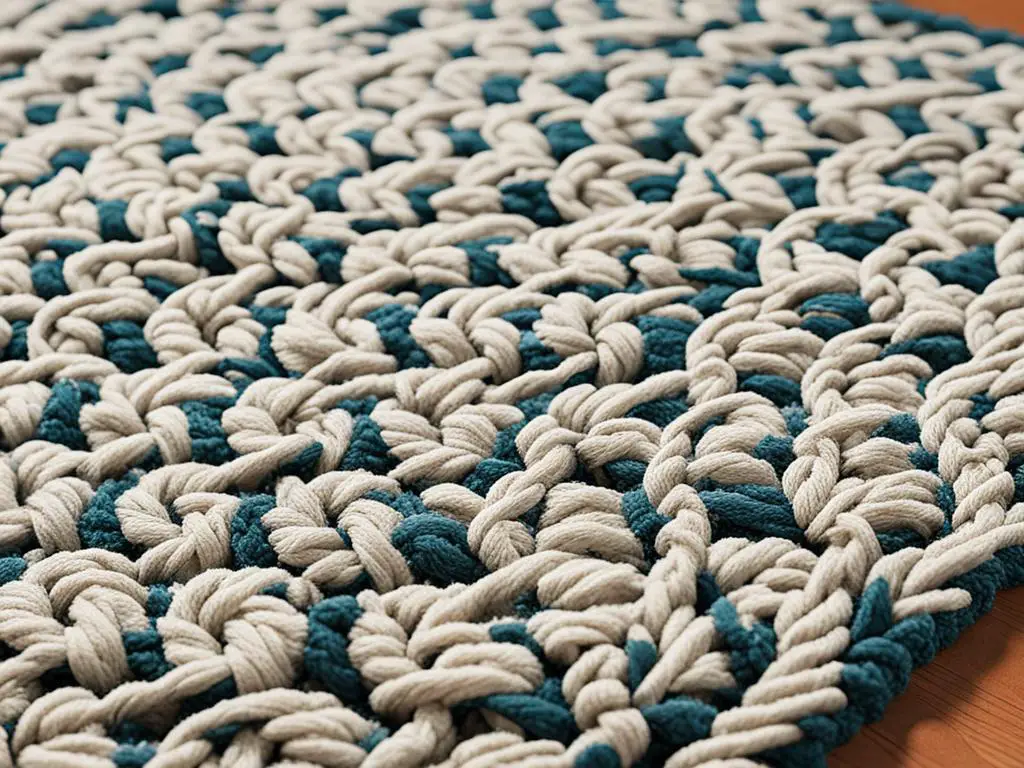 |
As you can see, hooked rugs have a looped surface pile, while tufted rugs have a cut pile. This distinction in construction creates different textures and appearances that can drastically change the overall look of a space.
Whether you prefer the rustic charm of hooked rugs or the luxurious feel of tufted rugs, both techniques offer unique qualities that can enhance any room. Consider your personal style and the desired ambiance when deciding on the right rug for your home.
Modern Trends in Hooked Rugs
Hooked rugs have come a long way, and today, we can explore the exciting modern trends in this craft. With the rise of contemporary design and DIY culture, the art of hooking rugs has seen a resurgence in popularity. Let’s take a closer look at some of the modern trends shaping the world of hooked rugs.
Fine Hooking
Fine hooking is a technique that uses thin strips of wool to create intricate designs. This approach allows rug hookers to achieve detailed patterns with beautiful shading and color variations. In fine hooking, overdyeing is often employed to add depth and dimension to the design. By dyeing the wool strips before hooking, rug makers can create unique and visually captivating rugs that showcase their artistic skills.
Primitive Hooking
Primitive hooking takes a different approach, using wider strips of wool and focusing on bold shapes and solid blocks of color. This style embraces simplicity and minimalism, emphasizing the beauty of simplistic motifs and strong visual impact. Primitive hooked rugs bring a sense of warmth and coziness to any space, making them a popular choice for rustic and farmhouse-inspired interiors.
Both fine hooking and primitive hooking offer exciting possibilities for rug designers and enthusiasts. Whether you prefer intricate details or bold simplicity, there’s a style of hooked rug that will resonate with your artistic vision.
DIY Hooked Rug Tutorials
If you’re eager to get started with hooked rug making, there’s no shortage of resources available. Many designers and experienced rug hookers have shared their knowledge through online platforms, offering DIY tutorials and step-by-step guides. These tutorials provide aspiring rug makers with the necessary skills and techniques to create their own beautiful hooked rugs. Whether you’re a beginner or an experienced crafter, these tutorials can help you bring your creative ideas to life.
When embarking on a DIY hooked rug project, it’s important to gather the right materials, including a hooking tool, backing material, and wool strips or fabric. Following the tutorial instructions carefully and experimenting with different designs will allow you to unleash your creativity and develop your own unique style.
By exploring modern trends and engaging in DIY tutorials, you can join the thriving community of hooked rug enthusiasts and create stunning pieces of art for your own home or as thoughtful gifts.
Remember, hooked rugs offer endless possibilities for creative expression. Whether you prefer the intricacy of fine hooking or the simplicity of primitive designs, the world of hooked rugs is waiting for you to explore and create something truly unique.
| Modern Trends in Hooked Rugs | Description |
|---|---|
| Fine Hooking | Uses thin strips of wool for intricate designs, achieves shading and color variations through overdyeing. |
| Primitive Hooking | Uses wider strips of wool for bold shapes and solid blocks of color, emphasizes simplicity. |
| DIY Hooked Rug Tutorials | Online resources and tutorials for beginners and experienced crafters to learn and create their own hooked rugs. |
Conclusion
Hooked rugs are a beautiful and versatile form of craft that has a long history and continues to be a popular choice for home decor. The variety of techniques involved in rug hooking allows for endless possibilities of artistic expression. Whether you are interested in creating your own hooked rug or admiring the craftsmanship of others, exploring the world of hooked rugs can be a rewarding experience.
From traditional designs that showcase intricate patterns to modern trends that embrace simplicity and bold shapes, there is a hooked rug style to suit every taste and aesthetic. The process of rug hooking has evolved over time, from using scrap fabrics to creating fine art pieces with carefully selected materials.
Whether you want to add a touch of warmth and character to your living space or you are looking for a unique handmade gift, a hooked rug can be a perfect choice. With their rich history, versatility, and endless creative possibilities, hooked rugs are sure to continue captivating the hearts of craft enthusiasts for generations to come.
